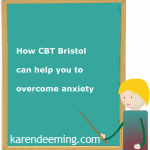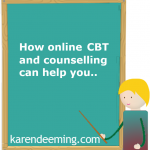In response to Coronavirus (Covid-19), I am offering telephone, online counselling and CBT sessions via Zoom and WhatsApp.
Do you sometimes feel like you are:
- losing control?
- about to faint?
- having a heart attack?
or at it’s worst a sense that you are going to die?
The symptoms of a panic attack can be very frightening and distressing.
According to the NHS definition:
“Symptoms tend to occur suddenly, without warning and often for no apparent reason.
As well as overwhelming feelings of anxiety, a panic attack can also cause a variety of other symptoms, including:
- a sensation that your heart is beating irregularly (palpitations)
- sweating
- trembling
- hot flushes
- chills
- shortness of breath
- a choking sensation
- chest pain
- nausea
- dizziness
- feeling faint
- numbness or pins and needles
- dry mouth
- a need to go to the toilet
- ringing in your ears
- a feeling of dread or a fear of dying
- a churning stomach
- a tingling sensation in your fingers
- shivering
- shaking
The physical symptoms of a panic attack are unpleasant, and they can also be accompanied by thoughts of fear and terror.
For this reason, people with panic disorder start to fear the next attack, which creates a cycle of living in ‘fear of fear’ and adds to the sense of panic.
Sometimes, the symptoms of a panic attack can be so intense they can make you feel like you’re having a heart attack.
However, it’s important to be aware that symptoms such as a racing heartbeat and shortness of breath won’t result in you having a heart attack. Although panic attacks can often be frightening, they don’t cause any physical harm. People who have had panic disorder for some time usually learn to recognise this ‘heart attack sensation’ and become more aware of how to control their symptoms.
Most panic attacks last for five to 20 minutes. Some attacks have been reported to have lasted up to an hour. However, it’s likely that in these cases one attack occurred straight after another or high levels of anxiety were felt after the first attack.”
Do you know why this happens?
It’s a phenomenon called “negativity bias,” a name coined by Psychologists, describing our human tendency to be much more likely to be influenced by and to recall negative experiences, instead of neutral or positive experiences.
So the good news is that panic attacks, anxiety and automatic negative thoughts are not wholly your fault it’s just the way your brain is wired and you can take steps to address this.
So instead of giving yourself a hard time, firstly, be kind and compassionate, reassuring yourself that you’re pretty normal and not alone in this very common dilemma.
Here’s some Neuroscience research:
- We recall negative feedback more than we remember praise.
- Unpleasant events tend to be more memorable than pleasant ones.
- The brain is programmed to be vigilant and wary.
- The brain reacts more strongly to negative stimuli than to positive stimuli.
- Studies indicate that there’s a greater flow in electrical activity in the brain when we visualise a negative image such as a dead cat than when we witness something positive like a glass of prosecco or yummy lemon cheesecake.
How can Neuroscience and a knowledge of the brain help with panic attacks?
For those of you who are unfamiliar, Neuroscience is the study of how the nervous system develops, its structure, and what it does. Neuroscientists focus primarily on the brain and its impact on behavior and cognitive functions
Neuroscience is an increasingly wide ranging subject. Perhaps because the brain is one of the most complex structures in the known universe:
- intricate enough to coordinate the fingers of a classical violinist
- or logical enough to introduce the laws and theories of gravity.
Now let’s take a brief glimpse at the brain
The right hemisphere is generally associated with creativity, communicating emotion, analysis of nonverbal information and the control of the left side of the body, temporal and spatial relationships.
Whereas, the left hemisphere is usually identified with logic abilities, casual relationships, sequential thinking, controlling the right side of the body and producing/understanding language and complexities.
The limbic system sometimes referred to as the “emotional brain” is usually considered as composed of the following:
cingulate gyrus, hypothalamus, hippocampus, thalamus and amygdala.
It is the site of: emotional states and behaviour; the bridge between the conscious and subconscious brain and short term memory/ information storage, especially short term recognition of facts, objects, people etc.
The amygdala, the brain’s alarm system is located in the limbic system. Its key function is to call you to attention, and in an emergency, to mobilise or shut-down your body and mind so that you’ll survive.
Sadly though, this alarm rings automatically and unnecessarily often incorrectly informing you that you are experiencing a flight or fight situation when the actual reality is that you are not and the alarm is just being over cautious.
When our amygdala misinterprets a bodily sensation such as sinking stomach to be a message of despair and pessimism, it has exactly the wrong result, reducing rather than enhancing our attention and alertness.
That’s why panic attacks, anxiety, frustration, anger and other chronic stress reactions can occasionally, or for some people frequently, escalate into huge problems. Put simply, we’re not using our amygdala as effectively as it was intended.
How can you tame your amygdala then?
Having studied this topic for many years now, by far the most comprehensive, informative book about neuroscience and the emotional brain I have read so far is the Chimp Paradox by Dr Stephen Peters.
As Coach of the Great Britain Cycling Team, and many business leaders, Peters developed a highly successful mind management programme using the term “Chimp Brain” as its premise.
The Chimp Brain
Peters asserts that “Chimp Brain” is an emotional part of our brain designed by evolution to support our survival.
Specifically, it is the area of the brain which activates the fight-or-flight response, hyperarousal, hypervigilance or the acute stress response, physiological reactions that occurs in response to a perceived harmful event or threat to our survival.
As it is fundamently concerned with two main instincts:
(1) survival and (ii) procreation
for example: sexual reproduction, hunger, thirst and protection of our territory.
The “Chimp” automatically jumps to opinions in the absence of concrete facts and may be paranoid, periodically resulting in catastrophic and irrational behaviour. For example when you are experiencing a panic attack the chimp often jumps to the wrong conclusion that you are having a heart attack or are going to die.
According to Dr Peters, the Chimp works on impressions, perceptions and interpretations, not facts and responds up to fives times faster than our rational brain.
Two other terms are also used by Peters, the Human Brain and the Computer.
The Human Brain
This Peters describes as the rational part of the brain highly effective at considering all the available facts and evidence and subsequently reaching careful and deliberate conclusions using cognition. It’s also where our highest values of humanity reside and it works five times more slowly than the chimp.
The Computer
A storage centre of retained experiences jammed full of automatic habits and responses, some positive, some negative. Above all though, when processing what is happening to us, both our Human and Chimp refer to the computer to seek associations and similar experiences. The Computer operates twenty times faster than our Human and four times faster than the Chimp.
You’re probably asking yourself right now how does all this relate to panic attacks then?
Peters argues that before taking any action, we firstly need to recognise these three powerful structures are continually operating in our mind. Furthermore, if we do not acknowledge this we will be perpetually running to catch up with ourselves.
This reminds of the mindfulness approach
Though we can’t stop our thoughts, feelings or physical sensations, we can take charge of what happens next. We can consciously step back, pause, breathe and choose to observe our panic attacks or negative thoughts rather than responding to them immediately.
Here’s some tips to help you regulate and tame the Chimp and as a result handle panic attacks more effectively:
1.Acknowledge that we as Human beings developed a negativity bias, that is, we evolved to notice and respond more forcibly to the negative, since that helped our ancestors to stay alive. Thousands and thousands of years ago, it was more important for cavemen to escape negative situations than it was to approach opportunity.
In other words, our ancestors wouldn’t even have stopped to analyse the situation. As soon as they noticed the slight rustle, like animals of prey, our ancestors would have simply fled for their lifes.
2.As it’s your “Chimp” it will respond sometimes when you are angry, stressed or perceive any kind of threat, physical or psychological, and it moves much more quickly than the Human part of your brain so is likely embarrass you with its responses. It might shout and rage, be rude and angry or violent.
3.Observe Chimp-like responses, these are easy to spot, they are responses which when you reflect later aren’t ones you’re proud of. They are likely the ones that if you had your time again you’d do differently, or they are the responses that you might, with the benefit of hindsight, think you need to apologise for.
4.Be aware that everyone has a Chimp and managing it is an everyday challenge, when we’re tired or stressed our Chimp becomes more difficult to control and can overwhelm us more easily. Observe other people’s responses, you can see Chimp behaviour everywhere.
5.Having become aware of your Chimp, you can work on taming it and rather than ignoring the Chimp’s instinctive and rapid reaction, just allow it to have its say. Then, consciously step back, pause, breathe and allow yourself more thinking time to work out a better, more considered Human response.
6.We can use the Computer part of our brain, our automated habits, to put in responses faster than the Chimp can react. This takes time and practice, but if we make a conscious effort to put in a different response to the impulsive Chimp one, we can develop what Peters calls an Autopilot, which is a script or response that overrides the unhelpful Chimp response before it can be enacted.
This rather reminds me of one Mindfulness tip I offer clients:
When you experience a panic attack, negative thought, feeling or physical sensation, breathe, pause, step back then ask yourself the following question:
“what do I know?”
“I know that if I tense my body my panic attacks will increase so I will try to be more calm and relaxed and say to myself it’s OK we’ll get through this”
“I know that if I allow my negative thoughts or panic attack bodily sensations to take over it is not healthy for me and will leave me feeling more stressed and anxious.”
“I also know that though I can’t stop my thoughts, feelings or physical sensations, I can change what happens next, such as, consciously deciding to stop myself from catastrophising or getting too attached to my thoughts.”
“I know that it is highly unlikely that I will experience a heart or die.”
“I know that thoughts aren’t facts”
Following your attempts at implementing the above strategy, record on a piece of paper the process of what happens when you try this technique and the automatic negative thoughts that stop you from supporting yourself.
To conclude
Understanding how your brain became so vigilant and wary, and so easily hijacked by alarm, is the first step toward gaining more control over that ancient circuitry.
Then, by bringing mindful awareness to how your brain reacts to feeling threatened, you can stimulate and therefore build up the neural substrates of a mind that has more calm, wisdom and sense of inner strength.
A mind that sees real threats more clearly, acts more effectively in dealing with them, and is less rattled or distracted by exaggerated, manageable, or false alarms.
You can book your appointment here or you can contact me on (044) +7950 751352 for outside the UK or 07950 751352 inside the UK. Alternatively by email: karen@karendeeming.com.


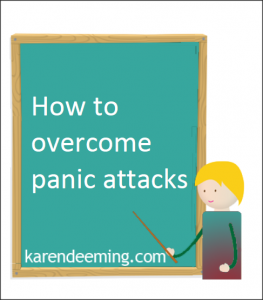

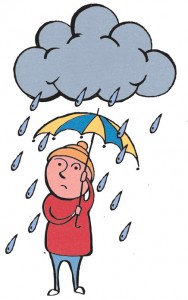

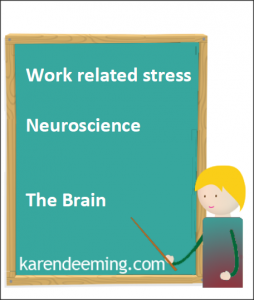
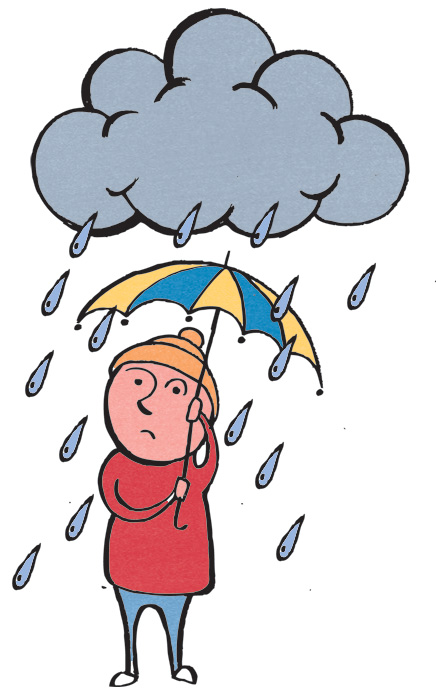


![Karen_Deeminga[1]](http://www.karendeeming.com/wp-content/uploads/2015/09/being-practice-self-portrait-e1541437891746.jpg) Welcome to my site. if you have any queries then please
Welcome to my site. if you have any queries then please
